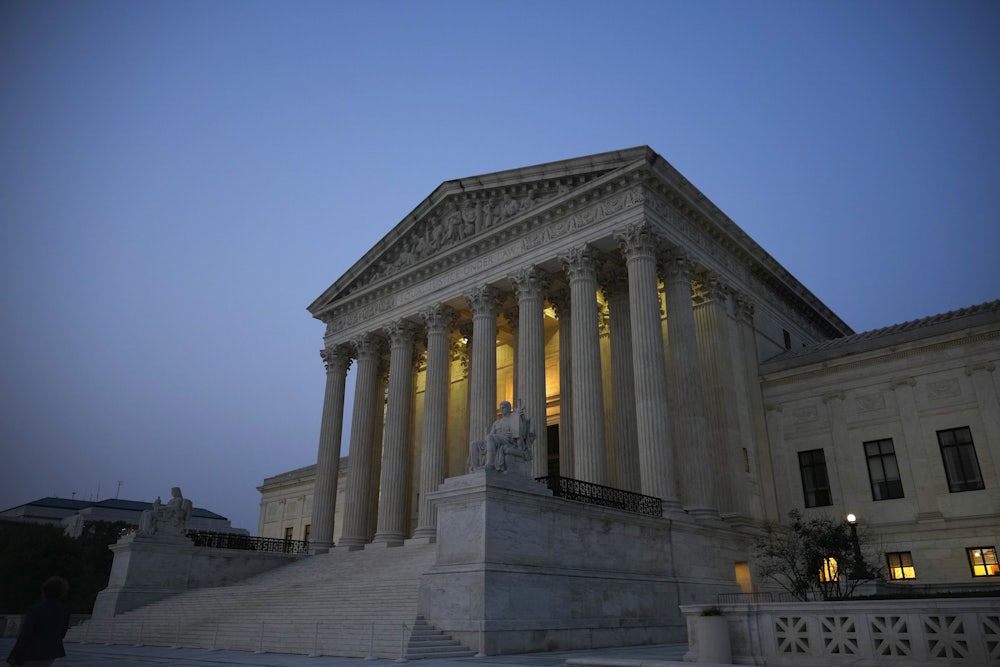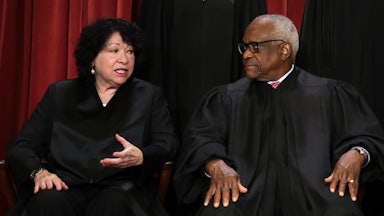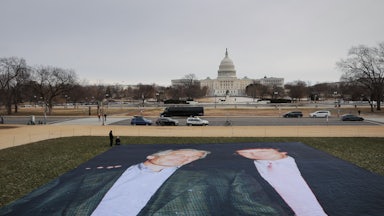Five years ago, a Louisiana prisoner handed prison intake officials a copy of a court decision that allowed him to keep his long dreadlocks for religious reasons. Prison officials responded by throwing that decision in a trash bin, holding the prisoner down, and forcibly shaving his head.
On Monday, the Supreme Court will hear oral arguments on whether those officials can be sued in their personal capacity for having violated the plaintiff’s religious rights. At issue in Landor v. Louisiana Department of Corrections is the religious freedom of hundreds of thousands of American prisoners, the laws that protect their rights behind bars, and how far Congress can go to provide them with remedies when their rights are violated.
The case began with Damon Landor, a prisoner in the custody of the Louisiana Department of Corrections. Landor is a longtime Rastafarian who took what is known as a “Nazarite vow,” in which he promised to abide by certain biblical restrictions. Among those promises is one to “let the locks of the hair of his head grow,” meaning that he won’t cut his hair or shave his head as a sign of fidelity to God. Landor maintained that vow for the last two decades.
Prisoners in U.S. prisons are generally required to maintain certain appearance standards, for reasons pertaining to hygiene and safety. At the same time, federal courts have often ruled in favor of exceptions to those requirements on religious grounds. The Fifth Circuit Court of Appeals ruled in the 2017 case Ware v. Louisiana Department of Corrections, for example, that the state’s grooming policy at the time violated a federal law known as the Religious Land Use and Institutionalized Persons Act, or RLUIPA, which covers (among other things) religious freedom claims in prisons.
In 2020, Landor began serving a five-month prison sentence. Along the way, he was held in three different facilities. The first two took no issue with Landor’s hair and allowed him to wear it openly or keep it covered under a “rastacap.” Three weeks before his sentence was set to end, however, he was transferred to the Raymond Laborde Correctional Center.
A Fifth Circuit panel described what happened next. “Upon arrival, Landor was met by an intake guard,” Judge Edith Brown Clement wrote for the panel in Landor’s case in 2023. “Acting preemptively, Landor explained that he was a practicing Rastafarian and provided proof of past religious accommodations. And, amazingly, Landor also handed the guard a copy of our decision in [Ware], which held that Louisiana’s policy of cutting the hair of Rastafarians violated RLUIPA.
“Unmoved by our caselaw, the guard threw Landor’s papers in the trash and summoned RLCC’s warden, Marcus Myers,” Clement continued. “When Myers arrived, he demanded Landor hand over documentation from his sentencing judge that corroborated his religious beliefs. When Landor couldn’t instantly meet that demand, two guards carried him into another room, handcuffed him to a chair, held him down, and shaved his head.”
Landor completed his sentence and promptly filed a lawsuit against the state, the warden, and other officials for violating his First and Fourteenth Amendment rights under RLUIPA, among other things. He argued that the prison’s treatment of him—made all the more egregious by its willful disregard of a Fifth Circuit decision that was literally handed to the guard—violated his constitutional rights and his religious freedom.
To understand Landor’s lawsuit and the lower court rulings on it, one must begin with the 1990 case Employment Division v. Smith. Oregon had denied unemployment benefits to two men who used peyote for Native American religious rituals. They sued in state court and argued that the denial of benefits violated their religious liberty, as protected by the First Amendment’s free exercise clause.
The Supreme Court rejected that argument and held that “neutral laws of general applicability” do not violate the free exercise clause. Justice Antonin Scalia, who wrote for the majority, rejected the notion that religious freedom claims could be used to opt out of otherwise nondiscriminatory laws. “Any society adopting such a system would be courting anarchy, but that danger increases in direct proportion to the society’s diversity of religious beliefs, and its determination to coerce or suppress none of them,” he wrote.
Scalia instead suggested that it was up to legislators to create exemptions or statutory mechanisms to address these claims. In response, Congress enacted the Religious Freedom Restoration Act to allow individuals to sue officials for alleged religious freedom violations. The law initially applied to both state and federal officials, but the Supreme Court nixed RFRA lawsuits against state officials in the 1997 case City of Boerne v. Flores. Such lawsuits, the court reasoned, went beyond Congress’s enforcement powers under the Fourteenth Amendment.
Congress enacted RLUIPA in 2000 in the wake of that decision. This time, instead of relying on the Fourteenth Amendment, lawmakers tied it to their spending powers by allowing federal religious freedom lawsuits against certain state and local agencies that receive federal funding, including prisons. (In practical terms, this appears to be all of them.) The Supreme Court has generally allowed that arrangement to stand since RLUIPA’s enactment.
That brings us back to Landor. In addition to suing the state and the prison, Landor also sued the warden in his personal capacity for violating his constitutional rights. A federal district court in Louisiana dismissed that portion of the lawsuit by holding that RLUIPA does not allow Landor to seek “compensatory or punitive damages” against officials like Myers in their individual capacities.
The district court was bound by a Fifth Circuit decision in 2009 that reached the same conclusion. Landor argued on appeal that things have changed since then. In the 2020 case Tanzin v. Tanvir, he noted, the Supreme Court allowed a plaintiff to seek damages against an official in their personal capacity for violating RFRA. That same reasoning, Landor argued, should apply to RLUIPA as well because of their common origins.
On appeal, the Fifth Circuit rejected that argument. The panel sympathized with Landor. Clement, writing for the panel, said that she and her colleagues “emphatically condemn the treatment that Landor endured,” which is unusually strong language for a judicial opinion. At the same time, she argued that the panel was bound by existing precedent that only the Supreme Court can change. While Tanzin provided for damages in RFRA cases, she explained, RLUIPA is different enough that it cannot be straightforwardly applied in Landor’s case.
Standing athwart Landor’s hopes is the state of Louisiana, which urged the justices not to expand RLUIPA to allow individual-capacity claims. Part of the state’s argument was that RLUIPA’s text did not clearly authorize such claims and that the court should not adopt such an expansive reading, given what Louisiana described as “uniquely weighty” federalism concerns.
The main thrust of its argument, however, was that the Tanzin ruling could not be cleanly applied to RLUIPA because it involved fundamentally different powers than RFRA. Since that law stems from Congress’s spending authority, the state argued, it amounts to a contract of sorts between Congress and the states. “Nonofficials”—meaning the state officials being sued in their individual capacity—aren’t part of that bargain.
“This court’s Spending Clause precedents inherently limit the imposition of spending-power conditions to funding recipients who are parties to the spending contract—not non-party ‘nonofficials,’” Louisiana told the justices. If RLUIPA is reinterpreted under Tanzin to allow such lawsuits, the state argued, then it would be unconstitutional.
In what amounts to a shoot-for-the-moon argument, Louisiana even argued that RLUIPA may be unconstitutional under any circumstances because of the court’s rulings on the Affordable Care Act more than a decade ago. In NFIB v. Sebelius, the Supreme Court upheld the law’s individual mandate to buy health insurance but struck down a provision that required states to expand access to Medicaid to receive further federal Medicaid funding.
“If the only way for the States to say no to RLUIPA is to withdraw from Medicaid, that ‘is a gun to the head’ and this is NFIB all over again,” the state argued, quoting from Chief Justice John Roberts’s ruling in the 2012 case. “Even ‘the threatened loss of over 10 percent of a State’s overall budget,’ the Court recognized, ‘is economic dragooning that leaves the States with no real option but to acquiesce in’ Congress’ preferred policy.”
Landor, for his part, found all of this to be an irrelevant sideshow. “This court should not address [the state’s] Hail Mary contention that RLUIPA ‘appears’ coercive because of a potential link to Medicaid,” he argued in a reply brief. It criticized the state for raising arguments it had not developed in the lower courts, and noted that since Louisiana prisons receive other federal funds, the state’s “observations about Medicaid are thus entirely academic.”
The Supreme Court has been friendly to religious freedom claims in the Roberts era, especially over the past decade. If nothing else, Tanzin shows how the justices are willing to read laws like RFRA in broad terms to make it easier to bring such claims in court. The conservative majority even came close to overturning Smith a few years ago, though some of the justices declined to go that far because there was no clear originalist alternative to replace it.
Siding with Landor might ultimately require the justices to expand and reinterpret RLUIPA in significant ways. Landor argued that his case showed that it was necessary to do so. “They could deny Kosher meals to Jewish inmates for failing to be Orthodox, force Muslim inmates to choose between observing a halal diet or suffering malnutrition, or entirely block access to Christian communion and church services,” he warned the justices. “Or they could just throw RLUIPA in the trash.” What might be an uncharitable exaggeration in other cases is merely factual in this one.










